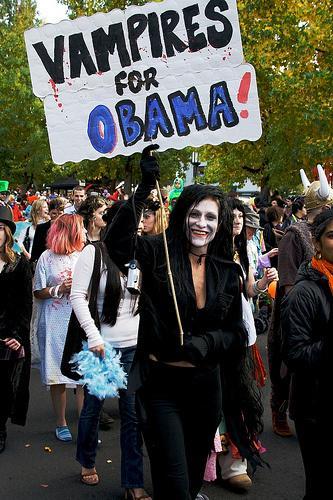
John Edgar Browning, a postdoc at the School of Literature, Media, and Communication, Georgia Institute of Technology, Atlanta, writes for The Conversation (via Business Insider), Mar. 27, 2015, that he spent five years conducting ethnographic studies of the real vampires living in New Orleans and Buffalo. “They are not easy to find, but when you do track them down, they can be quite friendly.”
The term “real vampires” is the collective term by which these people are known. While the “real vampires” are not immortal and don’t turn into bats, many of them sport fangs and live a primarily nocturnal existence — “cultural markers” adopted by the vampires “to express a shared essence – they need blood (human or animal) or psychic energy from donors in order to feel healthy.”
The “real vampires” claim that their vampiric nature begins to manifest around or just after puberty, derived from a “lack of subtle energies their bodies produce – energies other people take for granted.”
The “real vampires” have no national boundaries. They claim to be in Russia, South Africa, England and the United States.
John Edgar Browning found the vampires of Buffalo to be keen to keep up to date with the global community, while those in New Orleans were often more interested in the activities of their local vampire houses. A house is an affiliated group of vampires usually led by an elder who helps his or her house members to acclimate to their vampiric nature.
Some houses, and indeed whole vampire communities, as in the case of New Orleans, will combine their efforts to organize charity events, like feeding (not feeding on) the homeless. However, despite their humanitarian efforts, real vampires don’t go around advertising who they are for fear of discrimination by people who simply don’t understand them.
Browning claims that real vampires have existed since at least the early to mid-1970s, but his dealings with them began in 2009 when he entered the New Orleans vampire community with his digital voice recorder. There he met around 35 real vampires, half of the total vampire population in New Orleans. They ranged in age from 18 to 50 and represented both sexes equally.
The “real vampires” engaged in both blood (sanguinarian) and psychic feeding. A vampire psychically feeds by using its mind or hands to “take someone’s energy” — whatever that means. Some psychic vampires use tantric feeding, that is through erotic or sexual encounters; others use astral feeding or feeding on another from afar; still others feed through emotion.
The vampires told Browning that blood tastes metallic or “coppery,” although the taste can be influenced by the donor’s physiology or how well he or she is hydrated.
Both blood and psychic vampires said that after they’d fed, they feel “energized” — better than they would if they were to sustain themselves on regular food alone, although vampires do eat regular food, like fruits, fish, and vegetables.
The vampires described themselves as atheistic, monotheistic or polytheistic. Some identified as heterosexual, some homosexual and some bisexual. Some were married, some were divorced and some were parents.
Browning said he found the vampires he met to be “competent and generally outwardly normal citizens.” They performed blood-letting rituals safely and only with willing donors. They also get regular medical exams that scarcely (if ever) indicate “complications” from their feeding practices.
Browning found that the vampires he’d met were not knowledgeable about vampires in popular culture, nor did they take on the “trappings” of popular vampire lore. While many dressed in gothic clothes, it’s not all the time. Very, very few sleep in coffins.
Browning ended his article with a PC lecture:
But real vampires can also help us understand, and perhaps even shed, some of the ideological baggage each of us carries. They show us how repressive and oppressive categories can lead to marginalisation. Through them, we see the dark side of ourselves.
And so, in the end, as with every freak in the Untied [sic] States of America, it’s our (normal people) fault and we simply must be “tolerant” of the freaks. To do otherwise is to be “repressive and oppressive.”
Browning’s full report is published as “The real vampires in New Orleans and Buffalo: a research note towards comparative ethnography,” in Palgrave Communications, March 24, 2015.
An article in New York Daily News says there are at least 5,000 self-identified, human and animal blood-drinking vampires in the U.S., according to the Atlanta Vampire Alliance.
~Eowyn

